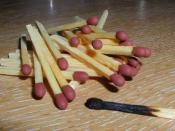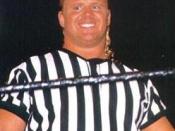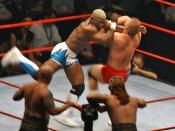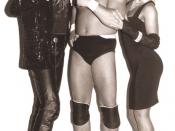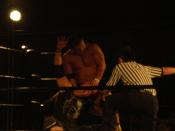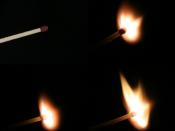Ring Psychology. Now some people know what this is. Some people don't. Some people may have a general idea of what it is, while some people don't. That's what this column is going to talk about (this column is purely my opinion, along with some references from Herb, so mad props to him, even though I agree fully with what he says) , and hopefully show those who don't know what ring psychology is all about, and maybe even give more knowledge to those who do.
Psychology invovles transitions, selling, and so forth. Without these elements, a wrestling match is just a collection of spots and moves. For example: RVD vs. Lynn (some of them), a lot of XPW/CZW deathmatches, and so forth. While many people consider these to be some of the greatest matches of all time, they lack a large amount of psychology, which leaves many of these matches as nothing more than a stunt show.
Transitions involve moving seamlessly from each spot to the next. If you were to run down a match, you would probably end up with something like "clothesline, legdrop, pin, pick up, bodyslam, pin". That sounds more like a training session than a real match. What's missing from the list of moves there? The Transitions. Look at a RVD/Lynn match. Yeah, they are great and full of highspots, but they have no transitions other than RVD running around and pointing at himself for 2 minutes in between each series of moves. It's like they are filming a highlight reel instead of a match. If they were to add in mat wrestling or whatever instead of the irrelevant taunting and so forth, the matches would be even better. Which leads to why a lot of BYW feds today aren't exactly top notch:
The lack of psychology in many top federations today has also lead to the lack of psychology in many, many backyard feds. Psychology has been described as doing the right thing, and doing it at the right time. Things like:
pacing: This envolves how much time to spend between big spots. For example, if both wrestlers clothesline each other, how long do you wait to get up? Or does the match have a "feeling-out" period at the beginning, which is just a slow way to get into the actual body of the match, instead of going full force from the start. Also, do you speed up the match as the finish comes near, to build up excitement and keep the audience on the edge of their seats. All of these things have to do with pacing, and they depend on the match-up, interest in the match, and so forth. But a good general idea is to have a "feeling-out" period for the first few seconds to a minute of the match.. whether it be a staredown, pushing and shoving, or a good solid chain of moves ending in a stand-still. Then, go into the body of the match, slow things down a little (more about the body of the match later), and then build up to the finish, and make the finish hot. Use many near falls, trademarks and finishers, and reversals until one wrestler finally comes out on top to make the match more exciting and to gather the attention of the audience.
selling: This can be described as reacting to the impact of the move. It's not just taking a bump. For example, staggering around after two punches and then falling on the third. Using facial expressions in submission holds. Favoring a body part after it has been attacked (limping, holding your arm etc.) You can apply selling to offensive moves as well. If you punch someone, and it sounds like it connected hard, (like Matt Hardy/Road Dogg's punches usually do), shake your fist to emphasise the fact that you really hit them, and you hit them hard. Or say your opponenet has been working over your arm. You go for a clothesline, but it hurts you instead. These are really simple things that really add to a match in a huge degree. However, don't oversell moves like Curt Hennig used to do. He would spin wildly in the air after a simple clothesline, and this isn't necessary. And don't be a no seller either unless it's to prove how tough you are. As in if you take a few chair shots or land on your neck like Masato Tanaka. Selling also relates to:
sensible moves: This is usually overlooked in BYW, considering the fact that most of us have some insane or creative moves that we want to jam all into one match. It makes sense to attack one body part throughout the match, but no sense to just randomly hit moves that affect all body parts. It wouldn't make sense for Benoit to attack someone's legs, slap on the crossface, and the guy tap out. That's not realistic. Same as the finishers that can "come out of nowhere" like the Stunner, Rock Bottom, and so forth. While they get a HUGE pop, there is no build-up to the actual use of the move. If you were to focus on someone's neck throughout the match, then pop the Stunner out of nowhere, you would still get the big pop, and it would look even more devastating (with good selling of course), and would make the match more realistic.
And that's one of the goals of wrestling right? To make everything seem realistic to the point that it looks like you are really hurting each other. If you can combine all of the above into your matches, then you are going to be able to put on a good show every time. And the above doesn't apply to just technical matches either. You can apply that to everything, be it hardcore, deathmatch, or whatever. Just put some thought into the matches, and they can usually be a lot better than two guys going out and hitting highspot after highspot just for the pops. Not that it's bad to have those kinds of matches, but you can still have those kinds of matches and work psychology into them as well.
